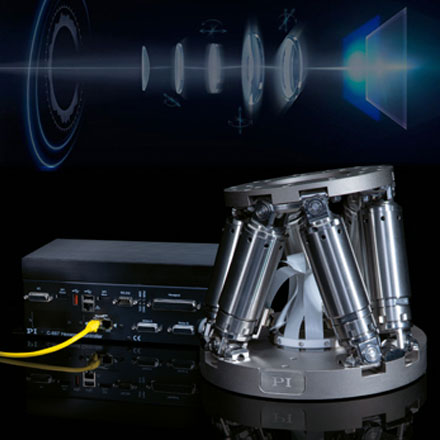|
|
Presented by
|

|
|

|
PART 1:
Hexapods are 6-axis parallel-kinematic machines often employed to solve complex multi-axis precision positioning and motion applications in fields such as photonics, optics, metrology, test and measurement, microassembly, motion simulation, and stabilization. This webinar will begin with a discussion on the basic principles of hexapod controls and software and compare the parallel setup with a serial kinematics setup, illustrating its advantages and limitations and looking into features such as stroke, workspace, precision, size, stiffness, dynamics, and its randomized pivot point functionality. The presentation will include a more detailed look into critical hexapod components, such as joints, and the effects of different drive systems and kinematic structures on applications and environments.
PART 2:
The webinar will also focus on intelligent algorithms and motion systems used for optimization of throughput in applications — such as active alignment of photonics circuits, optics, detectors, and emitters — and discuss the principles of PI’s fast alignment algorithms and the achievable performance with the latest positioning hardware. Further, the presentation will explore the challenge of reducing the complexity of the optical system to a couple of measurable parameters. Based on this knowledge, the presentation will explore how lens assemblies, beam shaping instruments, photonic integrated circuits, and even laser communication systems are tested, built, or operated based on PI alignment algorithms and motion systems. Solutions will be presented that support high throughput based on fast optimization routines and alignment systems.
Pictured: Hexapod. Courtesy of PI.
Who should attend:
System engineers, opto-mechanical designers, and everyone who employs precision motion systems for test, measurement, alignment, precision assembly, and optimization tasks.
About the presenters:
Dr. Michael Oldenburg’s Ph.D. in optics and photonics was received from Karlsruhe Institute of Technology, where he was also recognized for a best publication in the journal Advanced Materials in the field of solar energy from Karlsruhe School of Optics and Photonics. Oldenburg began his PI (Physik Instrumente) career as a technical sales engineer, consulting with customers on their demanding applications. He now joins the team in Singapore as a photonics and industrial automation field application engineer, tasked with building an application and service center to develop and test PI’s motion system on real problems.
Dr. Christian Rudolf is head of Product Division Hexapods at PI and holds a Ph.D. in mechanical engineering. He has more than 12 years of experience in designing complex mechatronic systems and applications, which also implies customer consultation at a very high level. Rudolf has led the group for hexapod design at PI for over six years.
About PI (Physik Instrumente):
PI (Physik Instrumente) designs and manufactures high-performance motion systems at locations in the U.S., Europe, and Asia. Industries and fields of application include silicon photonics wafer test, fiber alignment, laser processing, astronomy/aerospace, medical engineering, and big science projects. With over 50 years of experience developing standard and custom products based on piezoceramic and electromagnetic drives and more than 1300 employees in 13 countries, PI can quickly provide solutions for any positioning and automation project that requires high-precision motion control.
|
|
|
|
Date: Thursday, October 8, 2020
Time: 1:00 PM - 2:00 PM EDT
Space is limited. Reserve your Webinar seat now at: https://attendee.gotowebinar.com/register/2518564833269892367
After registering you will receive a confirmation email containing information about joining the Webinar.
|
|
|
SYSTEM REQUIREMENTS
Operating System
Windows® 7 or later, Mac OS® X 10.9 or later, Linux®, Google ChromeTM OS
AndroidTM OS 5 or later, iOS® 10 or later
Web Browser
Google ChromeTM (most recent 2 versions)
Mozilla Firefox® (most recent 2 versions)
Mobile Devices
AndroidTM 5 or later
iPhone® 4S or later
iPad® 2 or later
Windows Phone® 8+, Windows® 8RT+
|
|
|
|
.: More from Photonics Media
|
|
|
|